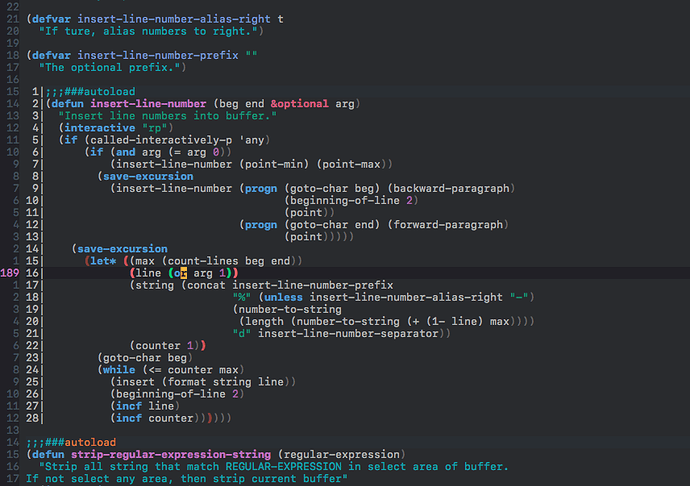(defvar insert-line-number-separator "|"
"The fancy separator used for `insert-line-number'.")
(defvar insert-line-number-alias-right t
"If ture, alias numbers to right.")
(defvar insert-line-number-prefix ""
"The optional prefix.")
;;;###autoload
(defun insert-line-number (beg end &optional arg)
"Insert line numbers into buffer."
(interactive "r")
(if (called-interactively-p 'any)
(if (and current-prefix-arg (= current-prefix-arg 0))
(insert-line-number (point-min) (point-max))
(save-excursion
(insert-line-number (progn (goto-char beg) (backward-paragraph)
(unless (= (point) (point-min))
(beginning-of-line 2))
(point))
(progn (goto-char end) (forward-paragraph)
(point))
current-prefix-arg)))
(save-excursion
(let* ((max (count-lines beg end))
(line (or arg 1))
(string (concat insert-line-number-prefix
"%" (unless insert-line-number-alias-right "-")
(number-to-string
(length (number-to-string (+ (1- line) max))))
"d" insert-line-number-separator))
(counter 1))
(goto-char beg)
(while (<= counter max)
(insert (format string line))
(beginning-of-line 2)
(incf line)
(incf counter))))))
;;;###autoload
(defun strip-regular-expression-string (regular-expression)
"Strip all string that match REGULAR-EXPRESSION in select area of buffer.
If not select any area, then strip current buffer"
(interactive "sRegexp:")
(let (begin
end)
(if mark-active
(setq begin (region-beginning)
end (region-end))
(setq begin (point-min)))
(save-excursion
(goto-char (or end (point-max)))
(while (and (> (point) begin)
(re-search-backward regular-expression nil t))
(replace-match "" t t)))))
;;;###autoload
(defun strip-blank-lines()
"Strip all blank lines in select area of buffer,
if not select any area, then strip all blank lines of buffer."
(interactive)
(strip-regular-expression-string "^[ \t]*\n")
(message "Have strip blanks line. ^_^"))
;;;###autoload
(defun strip-line-number()
"Strip all line number in select area of buffer,
if not select any area, then strip all line number of buffer."
(interactive)
(strip-regular-expression-string (concat (if insert-line-number-alias-right
"^ ?[0-9]+"
"^[0-9]+ ?")
insert-line-number-separator))
(message "Have strip line number. ^_^"))
用来在电子邮件里面发代码,或者用 C-u num 决定开始的行号:

这个代码片段里面用了一些不错的技巧。
